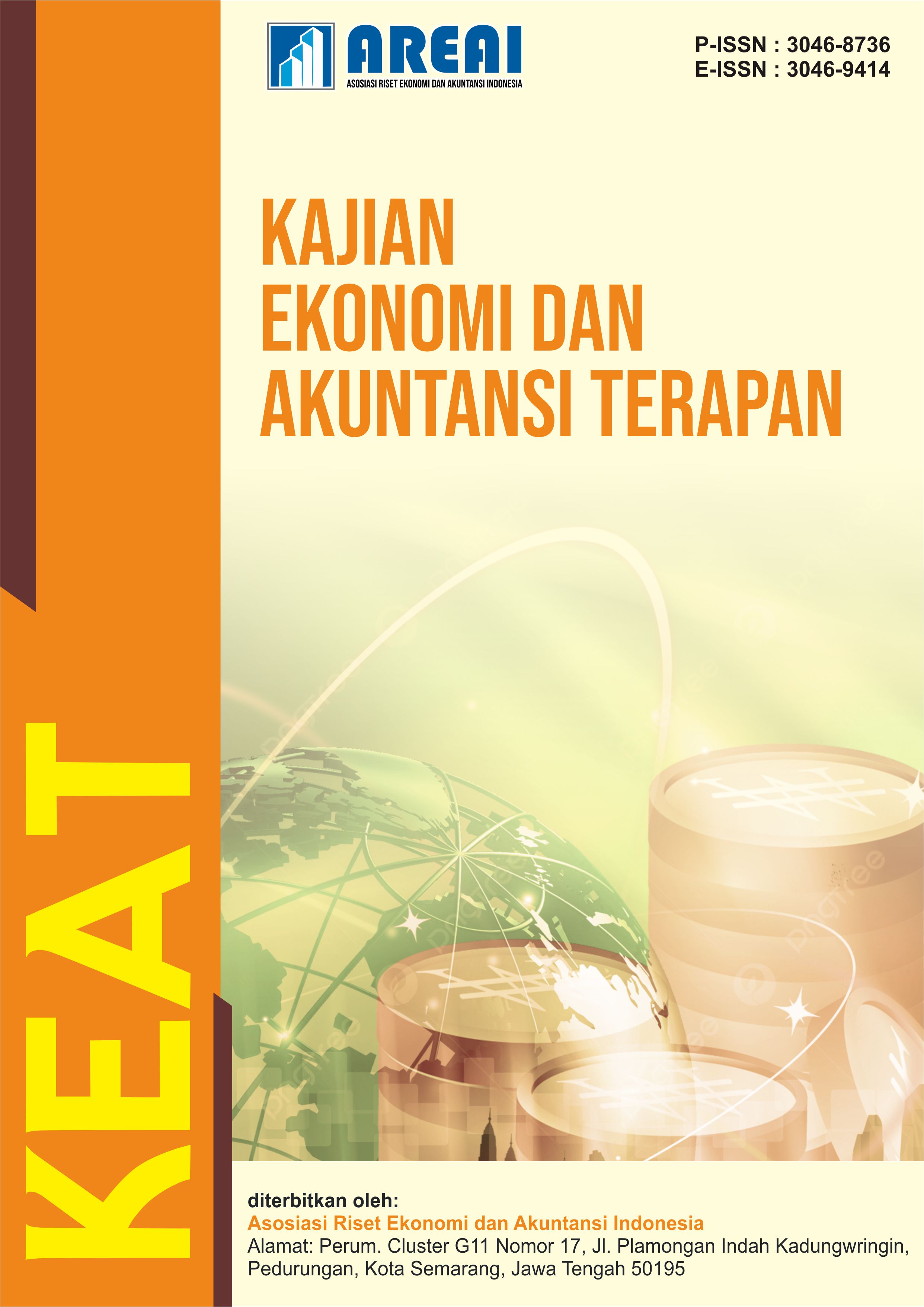Analisis Faktor-Faktor yang Mempengaruhi Ekspor Ikan Segar Indonesia
DOI:
https://doi.org/10.61132/keat.v2i3.1495Keywords:
Fish production, Fresh fish exports, Population size, Random Effect Model, Real GDP per capitaAbstract
International trade plays a vital role in strengthening Indonesia’s economic growth, particularly through the export of fishery products which are among the country’s leading commodities. Fresh fish exports are highly influenced by external demand factors in destination countries as well as Indonesia’s own production capacity. This study aims to analyze the determinants affecting Indonesia’s fresh fish exports to its main trading partners, namely China, Japan, Hong Kong, Singapore, and Malaysia, over the period 2012–2023. The research utilizes secondary data sourced from the World Bank and the Central Statistics Agency (BPS). Several independent variables are considered, including the fish production levels in the importing country, the real gross domestic product (GDP) per capita of the importing country, and the total population of the importing country. Panel data analysis was employed to capture the variations across time and countries, with the Random Effect Model (REM) chosen based on the results of the model specification tests. The findings of the analysis indicate that fish production in the importing country exerts a negative and statistically significant effect on Indonesia’s fresh fish exports, suggesting that higher domestic fish production in these countries reduces the need for imports. Conversely, the real GDP per capita of the importing country and its population size were found to have positive and significant impacts on Indonesia’s export volumes. These results highlight that wealthier and more populous nations demonstrate stronger demand for imported fresh fish, including from Indonesia. The implications of this study underscore the importance for Indonesia to continuously improve the quality, safety, and competitiveness of its fresh fish products while also adopting effective marketing and trade strategies targeting countries with high purchasing power and large consumer bases.
Downloads
References
Aryudiawan, C., & Suadi, S. (2022). Analisis pangsa pasar konstan terhadap ekspor perikanan Indonesia. Jurnal Perikanan, 24(1), 91–100. https://doi.org/10.22146/jfs.72860
Badan Pusat Statistik. (2024). Ekspor ikan segar/dingin hasil tangkap menurut negara tujuan utama, 2012–2023. https://www.bps.go.id/id/statistics-table/1/MjAyNCMx/ekspor-ikan-segar-dingin-hasil-tangkap-menurut-negara-tujuan-utama--2012-s2023.html
Baldwin, R., & Wyplosz, C. (2003). The economics of European integration (7th ed.). McGraw Hill.
Dompak Baharaja Tarihoran, A., Hubeis, M., Jahroh, S., & Zulbainarni, N. (2024). Building a sustainable institutional model for ornamental fish farming export villages in Indonesia. International Journal of Agricultural Sustainability, 22(1), 1–19. https://doi.org/10.1080/14735903.2024.2401203
Emam, M. A., Leibrecht, M., & Chen, T. (2021). Ekspor ikan dan pertumbuhan sektor pertanian: Kasus negara Asia Selatan dan Tenggara. Sustainability, 13(20), 11177. https://doi.org/10.3390/su132011177
Food and Agriculture Organization. (2022). The state of world fisheries and aquaculture 2022: Towards blue transformation. FAO. https://doi.org/10.4060/cc0461en
Gujarati, D. N., & Porter, D. C. (2012). Dasar-dasar ekonometrika (Edisi 5). Jakarta: Salemba Empat.
Ibnu, M., & Rosanti, N. (2022). Tren produksi dan perdagangan negara-negara produsen kopi terbesar di dunia dan implikasinya bagi Indonesia. Buletin Ilmiah Litbang Perdagangan, 16(2). National Research and Innovation Agency (BRIN). https://doi.org/10.55981/bilp.2022.5
Krugman, P. R., & Obstfeld, M. (2018). International economics: Theory and policy (11th ed.). Pearson Education.
Krugman, P. R., Obstfeld, M., & Melitz, M. J. (2021). International economics: Theory and policy (12th ed.). Pearson Education.
Lee, H. T., & Chen, Y. C. (2021). Fish import dependency and market dynamics in small island economies: A case study of Singapore and Hong Kong. Marine Policy, 131, 104679. https://doi.org/10.1016/j.marpol.2021.104679
Lestari, N., & Aisyah, R. (2024). Analisis pengaruh produksi terhadap ekspor rumput laut Indonesia. Jurnal Agribisnis dan Perikanan, 12(1), 45–58.
Mankiw, N. G. (2016). Principles of economics (8th ed.). Cengage Learning.
Nurhayati, E., Hartoyo, S., & Mulatsih, S. (2018). Pengembangan pasar ekspor lada Indonesia. Buletin Ilmiah Litbang Perdagangan, 12(2), 267–288. National Research and Innovation Agency (BRIN). https://doi.org/10.30908/bilp.v12i2.335
Raihanisyah. (2017). Analisis determinan dan daya saing ekspor karet alam Indonesia di pasar dunia. Indonesian Journal of Agricultural Economics (IJAE), 8(1), 1–15.
Ricardo, D. (2004). On the principles of political economy and taxation (P. Sraffa & M. H. Dobb, Eds.). Liberty Fund. (Original work published 1817).
Said, R. (2012). Demografi: Teori, model, dan aplikasi. Jakarta: Rajawali Pers.
Salvatore, D. (2020). International economics (13th ed.). Wiley.
Santosa, A. (2020). Analisis pengaruh kebijakan pemerintah, sistem logistik, dan kualitas produk terhadap kinerja ekspor di Pelabuhan Tanjung Emas Semarang. Jurnal Sains dan Teknologi Maritim, 20(2), 54–63. https://doi.org/10.33556/jstm.v0i1.188
Widarjono, A. (2018). Ekonometrika: Pengantar dan aplikasinya disertai panduan EViews (Edisi ke-5). Yogyakarta: UPP STIM YKPN.
World Bank. (2024). GDP per capita, PPP (constant 2021 international $) [Data set]. World Development Indicators. International Comparison Program. World Bank. https://data.worldbank.org/indicator/NY.GDP.PCAP.PP.KD
World Bank. (2024). Population, total. The World Bank Group. https://data.worldbank.org/indicator/SP.POP.TOTL
World Bank. (2024). Total fisheries production (metric tons). The World Bank Group. https://data.worldbank.org/indicator/ER.FSH.PROD.MT
Yuliadi, I., & Dwisyahputri, R. (2024). Analisis ekonomi ekspor ikan di negara ASEAN. E3S Web of Conferences, 595, 01025. https://doi.org/10.1051/e3sconf/202459501025
Downloads
Published
How to Cite
Issue
Section
License
Copyright (c) 2025 Kajian Ekonomi dan Akuntansi Terapan

This work is licensed under a Creative Commons Attribution-ShareAlike 4.0 International License.





